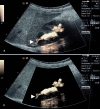Voiding urosonography with ultrasound contrast agents for the diagnosis of vesicoureteric reflux in children. I. Procedure
- PMID: 17618429
- PMCID: PMC2292498
- DOI: 10.1007/s00247-007-0529-7
Voiding urosonography with ultrasound contrast agents for the diagnosis of vesicoureteric reflux in children. I. Procedure
Abstract
Voiding urosonography (VUS) encompasses examination of the urinary tract with intravesical administration of US contrast agent (UCA) for diagnosis of vesicoureteric reflux (VUR). The real breakthrough for US examination of VUR came with the availability of stabilized UCAs in the mid-1990s. This article presents a comprehensive review of various procedural aspects of VUS. Different US modalities are available for detecting the echogenic microbubbles: fundamental mode, colour Doppler US, harmonic imaging and dedicated contrast imaging with multiple display options. The reflux is graded (1 to 5) in a similar manner to the system used in voiding cystourethrography (VCUG). The most commonly used UCA for VUS, Levovist, is galactose-based and contains air-filled microbubbles. The recommended concentration is 300 mg/ml at a dose of 5-10%, or less than 5%, of the bladder filling volume when using fundamental or harmonic imaging modes, respectively. There are preliminary reports of VUS using a second-generation UCA, SonoVue. Here the UCA volume is less than 1% of the bladder filling volume. There is no specific contraindication to intravesical administration of UCA. The safety profile of intravesical Levovist is very high with no reports of side effects over a decade of use in VUS.
Figures







Similar articles
-
Voiding urosonography with US contrast agents for the diagnosis of vesicoureteric reflux in children. II. Comparison with radiological examinations.Pediatr Radiol. 2008 Jan;38(1):54-63; quiz 126-7. doi: 10.1007/s00247-007-0528-8. Epub 2007 Jul 18. Pediatr Radiol. 2008. PMID: 17639371 Review.
-
Harmonic US imaging of vesicoureteric reflux in children: usefulness of a second generation US contrast agent.Pediatr Radiol. 2004 Jun;34(6):481-7. doi: 10.1007/s00247-004-1190-z. Epub 2004 Apr 24. Pediatr Radiol. 2004. PMID: 15107964
-
Voiding urosonography with second-generation contrast agent versus voiding cystourethrography.Pediatr Nephrol. 2010 Nov;25(11):2289-93. doi: 10.1007/s00467-010-1618-7. Epub 2010 Aug 5. Pediatr Nephrol. 2010. PMID: 20686902
-
Contrast-enhanced voiding urosonography with intravesical administration of a second-generation ultrasound contrast agent for diagnosis of vesicoureteral reflux: prospective evaluation of contrast safety in 1,010 children.Pediatr Radiol. 2014 Jun;44(6):719-28. doi: 10.1007/s00247-013-2832-9. Epub 2014 Jan 18. Pediatr Radiol. 2014. PMID: 24442338
-
Current status of vesicoureteral reflux diagnosis.World J Urol. 2004 Jun;22(2):88-95. doi: 10.1007/s00345-004-0404-1. Epub 2004 Jun 2. World J Urol. 2004. PMID: 15173954 Review.
Cited by
-
Contrast-enhanced voiding urosonography (ceVUS) with the intravesical administration of the ultrasound contrast agent Optison™ for vesicoureteral reflux detection in children: a prospective clinical trial.Pediatr Radiol. 2018 Feb;48(2):216-226. doi: 10.1007/s00247-017-4026-3. Epub 2017 Nov 27. Pediatr Radiol. 2018. PMID: 29181582 Clinical Trial.
-
Translational research in pediatric contrast-enhanced ultrasound.Pediatr Radiol. 2021 Nov;51(12):2425-2436. doi: 10.1007/s00247-021-05095-8. Epub 2021 May 15. Pediatr Radiol. 2021. PMID: 33991196 Free PMC article. Review.
-
Voiding urosonography with US contrast agents for the diagnosis of vesicoureteric reflux in children. II. Comparison with radiological examinations.Pediatr Radiol. 2008 Jan;38(1):54-63; quiz 126-7. doi: 10.1007/s00247-007-0528-8. Epub 2007 Jul 18. Pediatr Radiol. 2008. PMID: 17639371 Review.
-
Voiding urosonography with US contrast agent for the diagnosis of vesicoureteric reflux in children: an update.Pediatr Radiol. 2010 Jun;40(6):956-62. doi: 10.1007/s00247-010-1623-9. Epub 2010 Apr 30. Pediatr Radiol. 2010. PMID: 20432014 Review.
-
2D/3D/4D contrast-enhanced voiding urosonography in the diagnosis and monitoring of treatment of vesicoureteral reflux in children - can it replace voiding cystourethrography?J Ultrason. 2013 Dec;13(55):394-407. doi: 10.15557/JoU.2013.0042. Epub 2013 Dec 30. J Ultrason. 2013. PMID: 26674600 Free PMC article.
References
-
- {'text': '', 'ref_index': 1, 'ids': [{'type': 'DOI', 'value': '10.1007/s004670200010', 'is_inner': False, 'url': 'https://doi.org/10.1007/s004670200010'}, {'type': 'PubMed', 'value': '11793136', 'is_inner': True, 'url': 'https://pubmed.ncbi.nlm.nih.gov/11793136/'}]}
- Darge K (2002) Diagnosis of vesicoureteral reflux with ultrasound. Pediatr Nephrol 17:52–60 - PubMed
-
- {'text': '', 'ref_index': 1, 'ids': [{'type': 'DOI', 'value': '10.1016/S0140-6736(94)92123-7', 'is_inner': False, 'url': 'https://doi.org/10.1016/s0140-6736(94)92123-7'}, {'type': 'PubMed', 'value': '7915375', 'is_inner': True, 'url': 'https://pubmed.ncbi.nlm.nih.gov/7915375/'}]}
- Kaneko K, Kuwatsuru R, Fukuda Y et al (1994) Contrast sonography for detection of vesicoureteral reflux. Lancet 344:687 - PubMed
-
- None
- von Rohden L, Bosse U, Wiemann D (1995) Refluxsonographie bei Kindern mit einem Ultraschallkontrastmittel im Vergleich zur Röntgenmiktionszystourethro-graphie. Paediat Prax 49:49–58
-
- {'text': '', 'ref_index': 1, 'ids': [{'type': 'DOI', 'value': '10.1007/s00247-002-0812-6', 'is_inner': False, 'url': 'https://doi.org/10.1007/s00247-002-0812-6'}, {'type': 'PubMed', 'value': '12447589', 'is_inner': True, 'url': 'https://pubmed.ncbi.nlm.nih.gov/12447589/'}]}
- McEwing RL, Anderson NG, Hellewell S et al (2002) Comparison of echo-enhanced ultrasound with fluoroscopic MCU for the detection of vesicoureteral reflux in neonates. Pediatr Radiol 32:853–858 - PubMed
-
- {'text': '', 'ref_index': 1, 'ids': [{'type': 'PubMed', 'value': '10470914', 'is_inner': True, 'url': 'https://pubmed.ncbi.nlm.nih.gov/10470914/'}]}
- Mentzel HJ, Vogt S, Patzer L et al (1999) Contrast-enhanced sonography of vesicoureterorenal reflux in children: preliminary results. AJR 173:737–740 - PubMed
Publication types
MeSH terms
Substances
LinkOut - more resources
Full Text Sources

